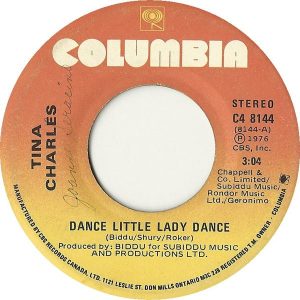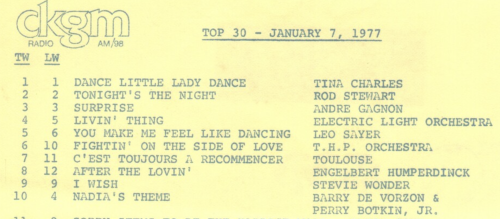#21: Dance Little Lady Dance by Tina Charles
City: Montreal, PQ
Radio Station: CKGM
Peak Month: December 1977
Peak Position in Montreal ~ #1
Peak position in Vancouver ~ did not chart
Peak Position on Billboard Hot 100 ~ did not chart
Peak Position on Swedish Singles chart ~ #2
Peak Position on Australian Singles chart ~ #4
Peak Position on UK Singles chart ~ #6
YouTube: “Dance Little Lady Dance”
Lyrics: “Dance Little Lady Dance”
Tina Charles was born Tina Hoskins in London, England, in 1954. By the age of 14, in 1969, she was working as a session singer. When Hoskins was taken to CBS Records, that year she released her first non-album single titled “Nothing in the World” with a then obscure piano player in the studio named Reginald Dwight (who was soon took the stage name Elton John). During the early 1970s, she supplied vocals for the Top of the Pops album series of cover versions of contemporary hits. In 1971, she made appearances in the first series of The Two Ronnies, the BBC1 sketch show starring Ronnie Barker and Ronnie Corbett, performing “River Deep – Mountain High”, “Ruby Tuesday” and other pop hits. Starting in the 70s, Tina Charles provided vocals and spoken word on a variety of TV commercials. These include Crosse & Blackwell, Vauxhall, Interflora and others.
In 1975, she provided backing vocals for the song “Make Me Smile (Come Up and See Me)” featuring Steve Harley and Cockney Rebel. The song climbed to number-one in Ireland and the UK, #5 in the Netherlands, and #7 in Belgium. Charles also provided backing vocals on the 5000 Volts hit “I’m On Fire”, which sampled the 1966 hit “Black Is Black” by Los Bravos. The single reached number-one in Belgium, Israel and West Germany, #3 in the Netherlands and Switzerland, #4 in Sweden, #5 in Australia, #7 in Austria and New Zealand, #9 in Ireland, and #10 in Norway and South Africa.
In 1975, her single “You Set My Heart on Fire” reached #3 in Belgium and Sweden, #6 in the Netherlands, and #7 in Spain.
In 1975-76, Tina Charles had a huge international hit with “I Love to Love (But My Baby Just Loves to Dance)”. The single peaked at number-one in Ireland and the UK, #2 in Norway and Sweden, #4 in South Africa, #6 in Australia and West Germany, #7 in New Zealand, and #8 in Argentina. In 1987, the song shot to #2 in France.
The Buggles made choices in the production of their 1979 hit “Video Killed the Radio Star” based on the production of “I Love to Love”. They had Tina Charles provide backing vocals on “Video Killed the Radio Star” who did a demo with “Oh-a-a-a-oh” thrown in. The Buggles liked it and included the vocalized vowels in the studio recording.
“I Love to Love” was accompanied by her debut album I Love to Love. The album topped the album charts in Norway and Sweden, and reached the Top Ten on album charts in Finland and Spain. In 1986, a remix of the song made the Top Ten in Austria, the Netherlands and West Germany. In 1976, her second studio album, Tina Sings, featured the single “I Can’t Dance to That Music You’re Playin'” which failed to chart. Later in 1976, a second track from I Love to Love titled “Love Me Like a Lover” became a Top 15 hit in West Germany, and a Top 30 hit in Belgium and the Netherlands, and #31 in the UK.

“Dance Little Lady Dance” was cowritten by Ron Roker, Gerry Shury, and Biddu Appaiah. Ron Roker was born in 1941 and worked in the sixties as a song-plugger. His first breakthrough was writing the theme song for the children’s TV show The Adventures of Rupert Bear (1970). He wrote the song “Rupert” which was a #14 hit for Jackie Lee in the UK in 1971. The following year Roker penned “Storm in a Teacup” which was an international Top Ten hit for the Fortunes. As well, in 1973 “When You’ve Gotta Go” was a #17 hit on the Dutch pop charts for Solomon King. In 1975, his song “Up in a Puff of Smoke” was a Top 20 hit for Polly Brown in Canada and New Zealand. Another song he co-wrote was “Guilty” which became a Top Ten hit for the Pearls in the UK. In 1983, Roker collaborated on the UK Eurovision contest entry “I’m Never Giving it Up”.
Gerry Shury was born in 1944 in Berkhamsted, a market town 26 miles northwest of London. He began working as a songwriter, arranger and record producer. He cowrote numerous songs with Ron Roker. Shury provided music for the 1972 film Hunted. Shury died in a car crash in 1978 aged 33. According to Ron Roker, he was returning to London late at night after visiting a club in Brighton when he fell asleep at the wheel of his car, which crashed, killing him instantly.
Biddu Appaiah was born in what is now the state of Karnata, India, in 1945. He began his music career in the 1960s, by singing as part of a music band in India before moving to England where he would start his career as a producer. He eventually found some success producing a hit song for Japanese band The Tigers in 1969, scoring the soundtrack for 1972 British film Embassy, and producing several early disco songs that would find a niche audience in British northern soul clubs during the early 1970s. He also wrote songs for The Flirtations, and Mac and Katie Kissoon.
Biddu’s international breakthrough came in 1974 when he produced “Kung Fu Fighting” performed by Carl Douglas. The single became an international number-one hit in over a dozen countries. He soon began producing his own instrumental albums under the name Biddu Orchestra, which started an orchestral disco trend in Britain and Europe with 1975 hits “Summer of ’42” (#14 on UK pop chart) and “Blue Eyed Soul”; his solo albums eventually sold 40 million copies worldwide. In 1976, Biddu produced Jimmy James’ “Now Is the Time” which reached #4 in the Netherlands and #5 in the UK. Biddu produced Jimmy James followup, “I’ll Go Where Your Music Takes Me”, which reached #23 in the UK. The Buggles bandmates, Trevor Horn and Geoff Downes, were former session musicians for Biddu.
In 1976, Biddu produced his own Rain Forest LP, followed by Eastern Man in 1977, both credited to Biddu & His Orchestra. His album Rain Forest earned him four Ivor Novello Awards, including the “Songwriter of the Year” award. In 1978, he scored music for the Joan Collins films The Stud and The Bitch. In total, Biddu has scored music for 11 soundtracks. His thirteenth and most recent studio album is Diamond Sutra from 2004. Biddu has been prominent in the emergence of Indian pop music, and pop music through Asia.
“Dance Little Lady Dance” offers lyrics where someone taught a lady how to ‘dance last night.” She found her rhythm, but she lost her self-control. The guy who taught the lady to dance was “a looker,” and “a cooker.” He taught her how to boogie and bump, both being types of dance moves. But there is sexual tension behind the song. The tale of the lady and the cooker she met might have led to her losing her self-control in places away from the dance floor.
“Dance Little Lady Dance” climbed to #1 in Montreal and Ottawa. Internationally, the single climbed to #2 in Sweden, #4 in Australia, #6 in the UK, #8 in the Netherlands and West Germany, #9 in New Zealand, #12 in Belgium, #13 in Spain, and #14 in Finland. A 1987 remix of “Dance Little Lady Dance” climbed to #9 in Belgium, #20 in the Netherlands, and Top 30 in Austria and Spain. With the hit single came Tina Charles’ third studio album Dance Little Lady, which peaked at #2 on the Norwegian Album chart, and #3 on the Swedish Album chart.
At the end of 1976, Tina Charles released the single “Dr. Love”. It climbed to #4 in the UK, #11 in Australia and Sweden, #20 in West Germany, and the Top 30 in New Zealand and Spain.
In 1976, Charles released her fifth studio album, Heart ‘n Soul, which reached #8 in Norway, and #11 in Finland and Sweden. In 1978, Charles was a joint winner at the World Popular Song Festival held in Tokyo, performing the tune “Love Rocks”. Charles represented the UK, and shared the top prize with Japan’s own entry.
By 1980, her career was in decline, and disco music generally was losing some of its public appeal. She attempted to change her disco style for her 1980 album Just One Smile for a more hard edge rock electronic style but the album was virtually ignored. Charles married and had a child, and devoted herself for some years to her family life, putting her singing career on hold.
Since 2000, Charles has performed throughout Europe, where disco music and her hit singles have been reappraised, and she has become a popular live performer. Charles featured in the Top 5 of the US Hot Dance Music/Club Play chart with “Higher” in 2006. The song was produced by Sanny X. She made a guest appearance with The Producers at their 2007 concert, singing “Slave to the Rhythm”. In October 2007, Charles recorded “Hide and Seek” with producer Ian Levine for the album Disco 2008. Her latest album, Listen 2 the Music, was released in March 2008.
In 2010, she went on tour with 5000 Volts, the band with which she experienced her first hit record. Between 1969 and 2015, Tina Charles released 44 singles, including 26 non-album singles.
July 2, 2025
Ray McGinnis
References:
“Tina Charles Interview,” Colly D Show, Soundcloud.com, 2024.
Tony Padman, “Whatever happened to disco queen Tina Charles famed for pop hit I Love To Love,” Express, UK, January 10, 2016.
Dave Simpson, “The Buggles: How we made Video Killed the Radio Star,” Guardian, October 30, 2018.
Tina Charles, “Good To Be Alive“, CBS Records, 1969.
“‘We Never Found Another Gerry Shury’ – the late genius of British soul,” Glitter Suits and Platform Boots, November 8, 2019.
Chriagsutar, “J D Rock Awards ’10 to honour Biddu with Lifetime Achievement award,” radio and music.com, February 2, 2010.

CKGM 980-AM Montreal Top Ten | January 7, 1977

Leave a Reply